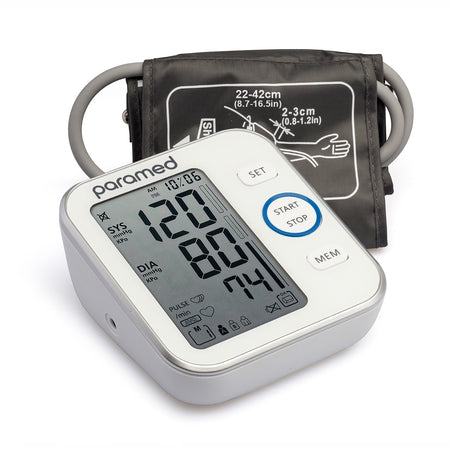Low blood pressure (Hypotension): symptoms, causes and treatment
Hypotension is an acute or chronic decrease in blood pressure by more than 20% of its normal value, leading to poor blood supply to the organs. The development of this condition is indicated by an Hg. Art. measurement of 90/60 mm or below.
The brain suffers first from hypotension when it does not receive the necessary amount of oxygen. Low blood pressure also leads to oxygen starvation of other organs and systems. As a result, metabolic products accumulate in the body, blood circulation slows down, and intoxication develops.
What can help you treat low blood pressure, allowing you to return to a regular rhythm of life? Read on to find out!
What is hypotension, and why is it dangerous for your health?
Hypotension is a steady decline in blood pressure to 100/60 mm. rt. Art. and below. It is accompanied by many characteristic symptoms from visual impairment and dizziness to increased fatigue and fainting.
The disease is a common among girls and adolescents, but sometimes affects older people with a background of atherosclerotic changes. If you are feeling the characteristic symptoms of hypotension, you should immediately contact a specialized doctor and undergo a diagnosis. Doing so will allow you to detect the problem promptly and carry out effective treatment that can return a person to a normal, healthy life.
The result of neglected hypotension can be several negative physiological changes that provoke dangerous, complex diseases, such as kidney failure.
Low blood pressure during hypotension worsens the patient's general well-being and does not provide effective oxygen exchange between the lungs, internal organs, tissues, and the brain. As a result, intellectual abilities may decrease, one’s ability to pay attention worsens, and the risk of loss of consciousness increases, often leading to physical injuries.

Types of low blood pressure
Hypotension brings no less discomfort than with hypertension. A timely appeal to a specialist can help you deal with it. Before they prescribe medications, they will determine the type of ailment.
Orthostatic hypotension
Orthostatic (postural) hypotension is an excessive blood pressure (BP) decrease when upright. It is usually interpreted by a decrease in systolic blood pressure more than 20 mm Hg., diastolic blood pressure by more than 10 mm Hg., or by reducing both parameters. In this case, weakness, dizziness, disorientation, or blurred vision may occur, lasting from several seconds to several minutes while the patient is standing upright and quickly passing when moving to a horizontal position. Some patients experience falls, syncope, or in rare cases, generalized seizures. Exercising or over-eating may cause symptoms to worsen.
Orthostatic hypotension is a manifestation of dysregulation of blood pressure against the background of various conditions, and it is not an independent disease. Increasingly, evidence suggests that impaired postural hemodynamic control increases the risk of cardiovascular disease and all-cause mortality.
Postprandial hypotension
This condition occurs after eating when blood flows to the vessels of the abdominal cavity to speed up digestion. One feels an increased heartbeat, weakness, drowsiness, dizziness, and sweating. Other symptoms such as vision and speech impairment, pain behind the sternum, and even fainting, are possible.
This type of hypotension is often called ‘dinner hypotension,’ occurring mainly in the elderly. Provoking factors can be neurological, endocrine diseases, and any deviations in mental development, such as neurasthenia or neurosis. Younger people have an easier time digesting heavy meals so their blood pressure is generally unaffected.
Neurally mediated
This is a drop in blood pressure that occurs after a prolonged state of rest or standing for a long time. This type mainly affects young people and children, often due to a momentary lack of synchrony between the heart and brain.
Multiple system atrophy with orthostatic hypotension
This rare form of hypotension results in progressive deterioration of the autonomic nervous system, which controls involuntary functions such as blood pressure, breathing, digestion, and heart rate.
Severe or shock hypotension
Acute symptomatic hypotension is a sudden drop in blood pressure. Very low blood pressure is often accompanied by acute myocardial infarction, pulmonary embolism, severe arrhythmias, intracardiac blockades, allergic reactions, and blood loss. In such cases, emergency medical care is required.

How do you know if you have hypotension?
The brain and other organs of those with low blood pressure suffer from a lack of oxygen. Addressing the symptoms will help to prevent intoxication and other serious health issues.
Main symptoms of low blood pressure
The primary symptoms of chronic arterial hypotension are typical not only for this disease, but also for other diseases of the cardiovascular system and gastrointestinal tract. They are:
- Decreased performance
- Fatigue
- Lethargy
- Headache
- Nausea
- Dizziness
The above symptoms indicate oxygen starvation due to a decrease in blood supply. The clinical nature of the disease manifests itself in other critical forms, such as:
- Confusion
- Cold, clammy sweat
- Shortness of breath
- Rapid, weak pulse
- Fainting
The general picture of symptoms is supplemented by oxygen starvation of brain cells.
Causes of hypotension
There can be many causes of hypotension. The primary form develops with disorders that directly affect the state of the blood vessels and provoke a reduction in pressure. Secondary hypotension is a symptom or consequence of another illness.
Causes of hypotension may be:
- Extreme stress or prolonged emotional strain
- Diseases of the cardiovascular system
- Diseases of the endocrine system
- Malignant neoplasms
- Stomach ulcers
- Cirrhosis of the liver
- Tuberculosis
- Diabetes
- Parkinson's disease
- Addison's disease
- Anemia
- Using certain medications
- Improper diet
Medical circumstances that may provoke low blood pressure are:
- Pregnancy. Changes during pregnancy lead to a quick dilation of blood vessels, resulting in a decrease in pressure. Hypotension is common in the first 24 weeks of pregnancy, and the condition is usually reversed after childbirth.
- Various conditions of the heart. Heart attack, heart failure, heart valve disease, and a low heart rate can cause low blood pressure.
- Hormonal diseases (endocrine disorders). Conditions affecting the thyroid or adrenal glands, such as Addison's disease, can cause low blood pressure. Low blood sugar (hypoglycemia) and occasionally diabetes may also cause low blood pressure.
- Low blood pressure caused by dehydration. When dehydrated, the volume of blood in the body decreases, which can lead to a reduction in blood pressure. Fever, vomiting, severe diarrhea, overuse of diuretics, and severe movement may lead to dehydration.
- Blood loss. The loss of large amounts of blood, such as from trauma or internal bleeding, lowers blood volume, resulting in a severe reduction in tension in the arteries.
- Severe infection (sepsis). When the bloodstream is contaminated, a life-threatening decline in blood pressure occurs; this condition is called septic shock.
- Severe allergic reaction. Signs of an extreme allergic reaction include a sudden decrease in blood pressure.
- Lack of nutrients. Low levels of vitamin B-12, folic acid, and iron can impair the production of enough red blood cells. Anemia can also be the cause of hypotension.
- The risk of arterial hypotension increases against the background of insufficient physical activity or, conversely, professional sports, as well as with an improper diet, constant fatigue, stress, and chronic illnesses.
Medical tests to resolve the cause of your low blood pressure
To diagnose hypotension, a general practitioner performs several actions:
- Carefully collects patient information about symptoms and analyzes the description of each of the symptoms of hypotension.
- Finds out if there are hereditary predispositions, negative factors, etc.
- Examines the patient, specifically the heart and lungs.
- Performs a three-time pressure measurement, and if necessary, establishes a blood pressure monitoring schedule for a week or more, including daily blood pressure monitoring.
- Gives a referral to a cardiologist, neurologist, or endocrinologist.
- Analyzes the composition of blood and urine, which includes a general and biochemical analysis, a blood test for glucose levels, a protein spectrum, and an ionic composition.
- Determines the level of catecholamines in the urine and blood, establishing an endocrine profile.
- Takes an ultrasound of the heart and conducts dopplerometry and electrocardiography tests.
- Conducts load tests.
In some cases, additional studies are performed before treatment, such as a CT or MRI of the head or an ultrasound of the kidneys, adrenal glands, or thyroid gland.
Managing low blood pressure
Each individual case determines the individualized treatment of arterial hypertension. If physiological options for reducing blood pressure are optimal, medical intervention is not required. For acute or secondary hypotension issues, medical treatment for the underlying cause of blood pressure disorders will be prescribed. In primary hypotension, complex non-drug and drug therapy is carried out.
Treatment of hypotension at home: general recommendations
The patient should maintain their daily health regimen, get enough sleep, avoid overwork, get the proper amount of exercise, keep interior air well-ventilated, and get plenty of fresh air. The patient’s diet must be optimal and tailored to their needs. Improve low blood pressure with food: it is best taken in small portions 4-5 times a daytime. Taking more salt, strong tea, or coffee to raise blood pressure should be discussed with your doctor.
Foods to avoid with low blood pressure
Nutrition plays an important role in treating hypotension, and there are many products that will help regulate blood pressure:
Complex carbohydrates. Cereals, legumes, and grains are essential foods for for the treatment of low blood pressure. As they are broken down and digested, they protect against an abrupt increase in blood glucose levels.
Berries and fruits. Polyphenols of berries and fruits strengthen the walls of blood vessels, regulate their permeability, and maintain the optimal volume of circulating blood.
- Fruits — oranges, bananas, kiwis, mangoes, apples, pears, apricots.
- Berries — strawberries, blueberries, raspberries, red and white currants.
Healthy fats. Olives, avocados, nuts, and seeds, such as sesame, pumpkin, hemp, linseed, and poppy seeds are sources of healthy vegetable fats. Oily fish (salmon, halibut, sardines, herring), eggs, lard, and red meat are good sources of animal fats.
Medical therapy
Drugs will help stabilize vascular tone, heart rhythm, and level of external negative factors, but only as prescribed by a doctor, as self-medication can cause harm.
Ethnoscience
In agreement with one’s doctor, natural treatment for hypotension is possible. Herbal teas, baths with decoctions of medicinal plants, honey, plant pollen, royal jelly, and other natural adaptogens can be used in treatment. Before using them, you should make sure that there is no possibility of allergic reaction.

How to prevent hypotension
General recommendations are not only suitable for patients with blood pressure problems, but generally apply to every person who cares about their health. Patients with hypotension should adjust their lifestyle in the following ways:
- Get 8 hours of sleep every night.
- Maintain a proper and nutritious diet.
- A special dietary regime is not required, but one must adhere to the general principle that food should contain a balanced amount of proteins, fats, carbohydrates, and vitamins.
- Walk 1 hour a day. Beginners can start with a 30-minute walk a day. If this is not possible, then do exercises at home (yoga, stretching, etc.). You can consult with an instructor and do an individual set of exercises.
- Avoid physical and emotional stress.
- Eliminate unhealthy habits, such as drinking alcohol and smoking.
- Measure blood pressure using blood pressure monitors.
- Keep a diary of daily observations and readings.
Recognizing triggers
Learn to recognize triggers and symptoms. Sit or lie down if you feel dizzy; these symptoms usually pass quickly. Children and teenagers who have low blood pressure due to body changes usually outgrow it. If you have orthostatic hypotension, avoid triggering symptoms, such as standing for too long.
Does stress cause low blood pressure? Emotionally upsetting situations can also lead to low blood pressure. While they can't always be avoided, knowing how stress and other factors can lead to low blood pressure is helpful. It is also possible that low blood pressure can lead to depression.
When should you contact a doctor
Emergency care is needed with a sharp drop in blood pressure, accompanied by:
- Chest pain
- Dizziness
- Fever
- Rapid, shallow breathing
- Pale skin
- Arrhythmia
- Loss of consciousness
If low blood pressure is normal for you and no new symptoms are present, it is sufficient to monitor your health as part of routine medical examinations. If any symptoms cause hypotension, make an appointment to see your doctor.
To reduce the effect of symptoms, the physician may advise drinking more fluids, slowly and gently getting up from a sitting or lying position, bypassing situations that demand prolonged standing (with nerve-mediated hypotension), giving up alcohol, and wearing compression stockings.
To determine the causes of hypotension and attain a management plan for hypotension, you need to contact a general practitioner or cardiologist.
Takeaway
Hypotension is a condition that can be asymptomatic, and many people don't even know they have it. For others, it can cause unpleasant symptoms and even interfere with daily life and activities. Diagnosis and treatment are necessary if you suspect you have low blood pressure. Correct diagnosis and treatment can help you avoid falls and other complications. Fortunately, this condition is often treatable, and your healthcare provider can explain many things to you that will help you take care of yourself.



